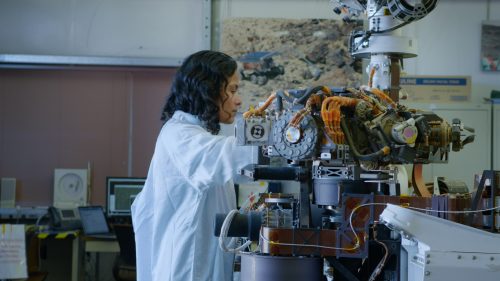Image courtesy of Minna Långström
Behind me, a path of tracks imprints the trail that I’ve trekked. Ahead, tawny slates and crumbled dunes stretch on. Though I stand alone in the valley of Dingo Gap on Mars, I fear no evil, for the desert is a planet away, and my presence is but an illusion.
Throughout her film, “The Other Side of Mars,” Minna Långström incorporates stunning images captured by NASA’s Curiosity Rover to give the viewer the sensation of stepping into the Martian landscape. Interspersing these with opinions from interdisciplinary experts, Långström explores not only on how NASA uses photographs to advance scientific discovery, but also how these photographs reflect and define reality. The audience meets a roboticist peering into visuals with a concern for the rover’s safety, a geologist recounting the sentiment behind the photograph of Dingo Gap, and a media theorist explaining science fiction writers’ desire to experience the new space in the images. “My goal was to somehow take the viewer through this journey where, in the end of the film, she or he would be thinking of the image almost as a three-dimensional, spectral object that can be so many different things at the same time,” Långström said. She argues that the same photograph, viewed through different lenses, can yield multiple interpretations of reality.
Moreover, the same photograph can itself be altered in an attempt to better appeal to viewers, but this process is controversial. In one clip, a sociologist describes that as the aesthetic quality of scientific photographs increases, so does the public’s suspicion of them. Yet Långström’s film illustrates the black holes of information missing in individual images, and elucidates why NASA must stitch scenes. “Scientists alter the images so that they can see more; they use filters and spectroscopes and all kinds of ways of getting more information,” Långström said. This manipulation is not malevolent. Rather than to persuade, it aims to extract sensory details, such as infrared wavelengths that our eyes cannot discern unless color-coded by computer.
Such relationships between subjective perception and objective representation underlie the film. After all, Långström chooses photographs to impart her interpretation of how photographs, themselves, craft perception. Wielding creative direction, she alludes to Sara Ahmed’s essay “Orientations Matter” to hint at the broader power of narrative in scientific communication. “We have a perspective of history that is very exclusive … when white male perspectives are much more represented than others, their version of reality, however sharp imagery they are using, is not reflecting reality anyway,” she said. The historical exclusion of women from film has affected Långström’s own experience of discomfort in her field, but she believes we can address inequality by involving a broader spectrum of people in all discussions.
In fifty-five minutes, “The Other Side of Mars” beautifully advocates for the melding of diverse perspectives, in terms of field and background, to create a more complete portrait of Earth, Mars, and the infinity beyond.
Citations:
M. Långström, personal communication, October 24, 2019.
Karpo, L. (Producer), & Långström, M. (Director). (2019). The Other Side of Mars [Motion picture].

